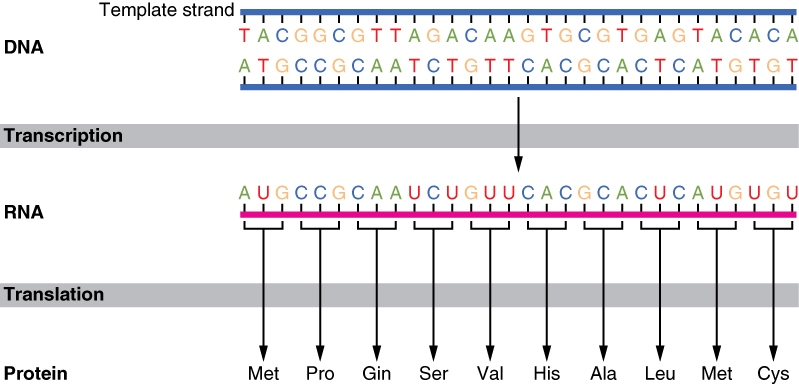To date, the National Center for Biotechnology Information (NCBI), which houses all published DNA sequences (as well as RNA and protein sequences), currently acknowledges nineteen different coding languages for DNA… “so much for a universal ancestor. (italics mine)
https://www.ncbi.nlm.nih.gov/pubmed/20394065
Dr. Rossiter (in his book “Shadow of Oz”) points out that universal genetic code isn’t anywhere close to correct, and it presents serious problems for the idea that all life descended from a single, common ancestor.”
How a cell makes proteins:
To understand the importance of Dr. Rossiter’s point, you need to know how a cell makes proteins. The “recipe” for each protein is stored in DNA, and it is coded by four different nucleotide bases (abbreviated A, T, G, and C). That “recipe” is copied to a different molecule, RNA, in a process called transcription. During that process, the nucleotide base “U” is used instead of “T,” so the copy has A, U, G, and C as its four nucleotide bases. The copy then goes to the place where the proteins are actually made, which is called the ribosome. The ribosome reads the recipe in units called codons. Each codon, which consists of three nucleotide bases, specifies a particular amino acid. When the amino acids are strung together in the order given by the codons, the proper protein is made.
The genetic code tells the cell which codon specifies which amino acid. According to the supposedly universal genetic code, those three nucleotide bases in that order are supposed to code for one specific amino acid: methionine (abbreviated as “Met” in the illustration). The next codon (CCG) is supposed to code for the amino acid proline (abbreviated as Pro). Each possible three-letter sequence (each possible codon) codes for a specific amino acid, and the collection of all those possible codons and what they code for is often called the genetic code.
Various organisms use a different coding language.
Various organisms use the same set of codons for the same amino acids however others do not use this “universal genetic code”. Some codes translate different and some are translated at the ribosome, etc. These varying forms of code languages argue against evolution.2
As an update to the article, seeming to distort this clear use of different languages or coding patterns used by DNA, Dr. Wile points out that evolution popularizers now maintain that the term “universal” no longer implies that all the codons are the same in all organisms.2 So, they are essentially saying “universal” now also means “different”. Such is an oxymoron– is the coding universal or different? In the end, it seems this wide variation in the genetic coding has dealt a serious blow to the hypothesis of common ancestry.
1 http://www.biologyreference.com/Fo-Gr/Genetic-Code.html titled “Genetic Code”
2 Dr. Jay L. Wile blog “DNA uses at least 19 different coding languages; Universal Genetic Code? No!” Jan 18, 2016; https://blog.drwile.com/universal-genetic-code-no/
Main Image: https://openstax.org/books/anatomy-and-physiology/pages/3-4-protein-synthesis


